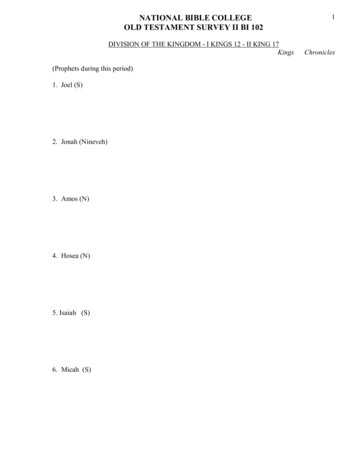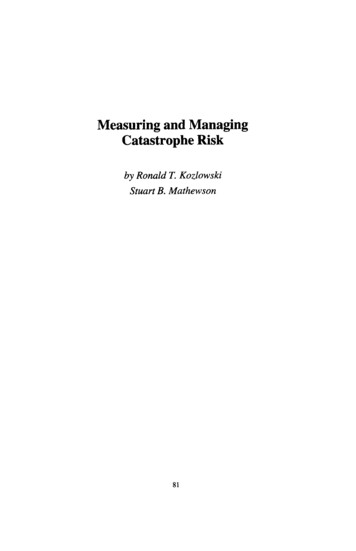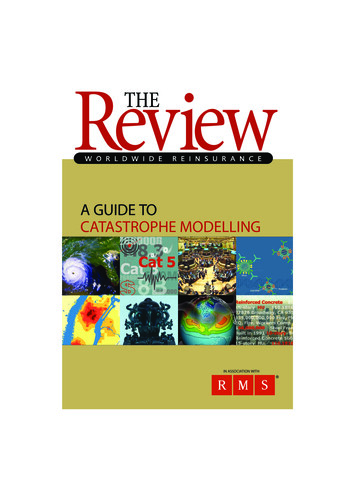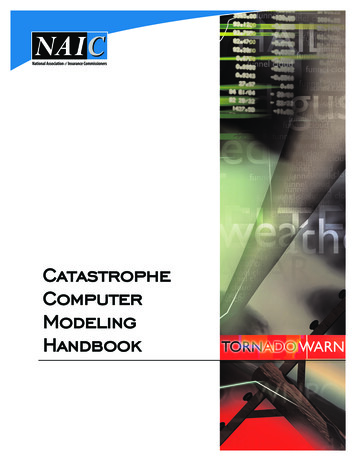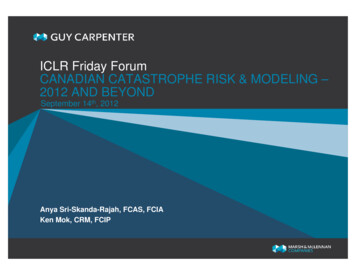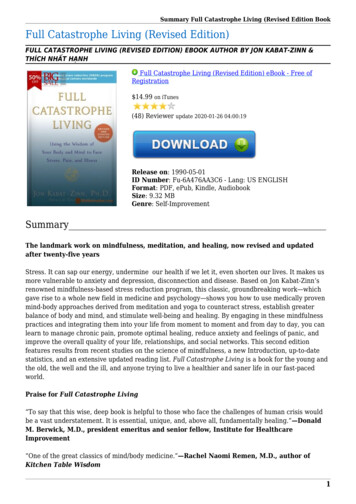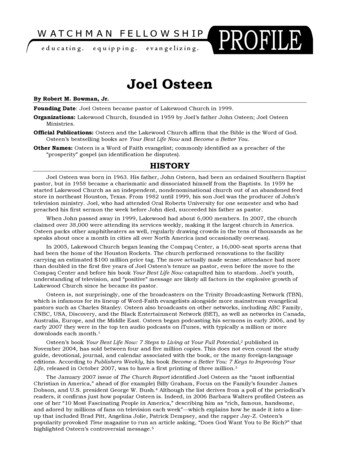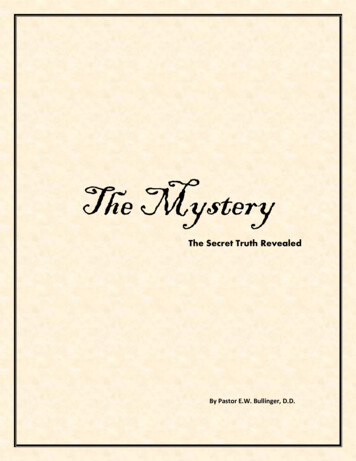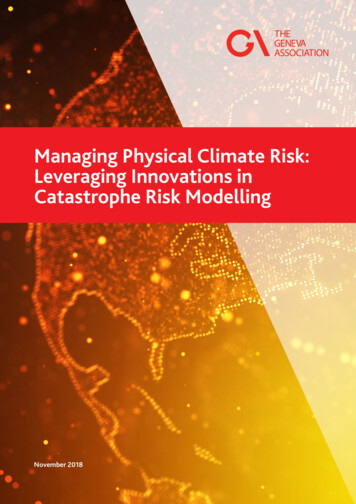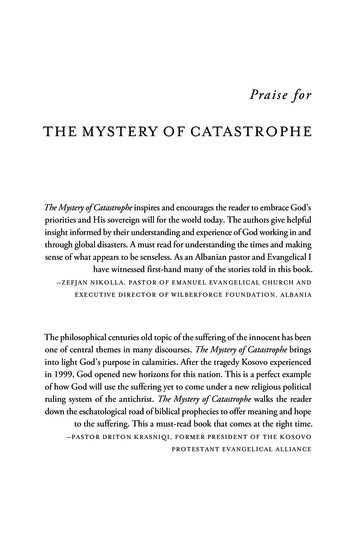
Transcription
Praise forTHE MYSTERY OF CATASTROPHEThe Mystery of Catastrophe inspires and encourages the reader to embrace God’spriorities and His sovereign will for the world today. The authors give helpfulinsight informed by their understanding and experience of God working in andthrough global disasters. A must read for understanding the times and makingsense of what appears to be senseless. As an Albanian pastor and Evangelical Ihave witnessed first-hand many of the stories told in this book.—Z EFJA N NIKOL L A, P ASTO R O F E M ANUE L E V A N G E LI C A L C H U R C H A N DEXECU TI VE DI RE C T O R O F W I L B E RFO R C E F O U N D A T I O N , A LB A N IAThe philosophical centuries old topic of the suffering of the innocent has beenone of central themes in many discourses. The Mystery of Catastrophe bringsinto light God’s purpose in calamities. After the tragedy Kosovo experiencedin 1999, God opened new horizons for this nation. This is a perfect exampleof how God will use the suffering yet to come under a new religious politicalruling system of the antichrist. The Mystery of Catastrophe walks the readerdown the eschatological road of biblical prophecies to offer meaning and hopeto the suffering. This a must-read book that comes at the right time.—PA S TOR DRI T O N KRASNI Q I , FO RM E R PR E S ID E N T O F T H E K O S O V OP RO T E ST AN T E V A N G E LI C A L A LLI A N C E
Christians have been trying to go to the ends of the earth to make disciplesfor years. And now God is bringing the world to Christians. The Mysteryof Catastrophe is a profound look at how God uses catastrophes and crisisto scatter unbelievers throughout the world. This book will challenge yourthinking on refugees and the end times.— HUGH O . M AC L E LLA N , C H A I R MA N E ME R I T U S ,THE MA C LE LLA N F O U N D A T I O NThe Mystery of Catastrophe is a critically important and genuinely propheticword for this hour. Not only does it identify the great challenges of the lastdays, but much more importantly, it lays out a clear Gospel-centered response.”—JOSEPH FARAH, CEO WND
THE MYSTE RY OF CATAST ROPHECopyright 2018 by Joel Richardson and Nathan GravesAll rights reserved. No part of this book may be reproduced in any form or by any means—whetherelectronic, digital, mechanical, or otherwise—without permission in writing from the publisher, exceptby a reviewer, who may quote brief passages in a review.Unless otherwise indicated, all Scripture references are from the New American Standard Version(NASB). Copyright 1960, 1962, 1963, 1968, 1971, 1972, 1973, 1975, 1977, 1995 by The LockmanFoundation. Scripture marked niv is from the Holy Bible, New International Version , niv Copyright 1973, 1978, 1984, 2011 by Biblica, Inc. Used by permission. All rights reserved worldwide. Scripturemarked esv is from the Holy Bible, English Standard Version. esv Text Edition: 2016. Copyright 2001 by Crossway Bibles, a publishing ministry of Good News Publishers. Scripture marked isvCopyright 1995-2014 by isv Foundation. ALL RIGHTS RESERVED INTERNATIONALLY. Usedby permission of Davidson Press, LLC.Book designed by Mark KarisHardcover ISBN: 978-1-949729-00-9eBook ISBN: 978-1-949729-03-0Printed in the United States of America
To my wife, Lorraine, the love of my life, and to the greatest earthly gifts God evergave to me—my two sons, Josiah and Justin
ContentsAcknowledgementsPrefacexxiPA R T 1A B I B L I C A L T H E O L O G Y O F C A T A S T RO P H ENathan GravesIntroduction12345Biblical History of CatastropheHis Way Is in the WhirlwindThe Mystery of CatastrophePresent-Day ExamplesThe Big Picture of Catastrophe13725354757PA R T 2W H AT COM E S N E X T ?Joel Richardson678910A World of CatastropheThe Last ReichThe Spirit of AntichristThe Lord’s Purpose for the AntichristOur Response69718199121137
PA R T 3HOW T H E N SH A L L W E R E SPON D?Nathan Graves151111213The Grand ClimaxRising to the TimesA Missionary for the Times153165179Notes192
Ac k n ow l e d gementsmy Savior Jesus Christ first of all, for so greata salvation He lavished on me and for putting this book in my heart. Ithank my wife, Lorraine, for all her prayers, encouragement, support,and helpful insights. Special thanks to James Beery, my dear and precious friend, mentor, high school football coach, and English teacherwho gave me a love for writing and has modeled for me the life of agodly man. Finally, I want to thank Joel Richardson, a man of God whobelieved in me, supported me, and gave me this amazing opportunityto share with you what burns deeply in my heart.I WA N T T O T H A N KNATHAN GRAVESI would like to thank my wife, Amy, for her unwaveringsupport. Many thanks to Geoffrey Stone for your critical assistanceand editorial oversight. It’s deeply appreciated. Much thanks to MarkKaris for another great cover design. To all those partners who continueto support the work the Lord has given us to accomplish, and who sofaithfully cover my family and me in prayer, I simply cannot thank youenough. May the Lord return all of the blessings that you’ve given tome back on to you in multiplied abundance. Finally, thanks to NathanGraves for your partnership and great patience with this project. Maythe Lord use it mightily for His purposes.A S A LWA Y S ,JO E L R I C H A R D S O Nx
Prefac ein 2014, in what is now called theRepublic of Northern Macedonia. At that time, Nathan and his wife, Lorraine, had been working in Albania for nearly twenty-one years. Nathanorganized a strategic conference in the Balkans addressing the great challenges faced by the evangelical churches. I speak at a lot of conferencesand in churches all over the world. This particular event was not simplyimpressive—it was inspired. To understand the power of what took placethat year, one first needs to understand a few things about the Balkans.The Balkan Peninsula is a part of the world that most Americans knowvery little about. Occupying the whole of southeastern Europe, today itis comprised of around thirteen countries. Throughout this region, thereare a multiplicity of ethnic, religious, and social identities—and divisions.During the Cold War, much of this region was somewhat unifiedunder the banner of Yugoslavia. During the 1990s a series of warsripped the region apart. In fact, the very term Balkanize has come torefer to the breaking up of a region into smaller and more hostile units.During this period of splintering and war, more than 150,000 peopledied. It was also during this time that the evangelical movement beganto make its first solid inroads in the area. This is when Nathan and hisyoung family moved to the region. In a baptism by fire so to speak, theygave themselves to a place where the soil was soaked with blood and thepeople were deeply divided.I F I R S T M E T N A T H A N G R AV E Sxi
P refaceAlthough some time had passed, the painful memories of thenineties, remained. In many cases, the painful memories and divisionswent back centuries. Today, there is still a tremendous amount of fear,prejudice, and division along national, ethnic, and religious lines. Insome of the countries, the Muslim population is nearly 90 percent,whereas in other countries, Eastern Orthodox Christianity is dominant.Although the evangelical movement is firmly established there, theyremain a minority, and are often looked at with suspicion. This is whyI was so impressed with Nathan’s leadership skills in organizing such aconference in that region. He had managed to gather more than twohundred prominent Christian leaders from nearly every nation in theBalkans. Even more impressive was the fact that there was nearly anequal number of Pentecostals as there were Baptists. Anyone who hasbeen in ministry long knows that mixed denominational meetings rarelyhappen smoothly. Because of his commitment to the kingdom of God,however, Nathan managed to organize and pull off the impossible.In the back of the room, several booths were set up for the manylanguages that were simultaneously translated throughout the conference. The few days that we gathered were among some of the mostpowerful, anointed, and blessed times of worship and fellowship thatI have ever experienced. There was also a certain prophetic nature tothe event. Among the primary purposes of the gathering was to discusshow evangelical leaders throughout the region could strategize andpartner together to reach out to their Muslim neighbors and stand upto the creeping shadow of radical Islamization. I was blessed to be oneof the keynote speakers and share some of the insights that I’ve gainedby giving myself to this great challenge for the past few decades.It was during this conference that I began to discern that Nathanwould become a strategic partner in my own ministry. A year earlier I hadtraveled deep into the Rhodopy Mountains of Bulgaria to visit a smallchurch that is reaching out to the many remote Muslim villages there.It was during that trip that I came to realize how strategically importantthe Balkans are. These fractured nations, often forgotten by many in thexii
P refaceWest, represent the door from the Middle East to Europe. Today, thereis a very real spiritual, as well as geo-political, battle for control of thattremendously important gateway. I realized then that the Balkans willplay a tremendously important strategic role in the work of proclaimingthe gospel to all nations before Jesus returns. Thus, it was not a shockwhen the very next year, Recep Tayyip Erdogan, the emerging dictator inTurkey, opened the floodgates and allowed over a million refugees fromthe Syrian conflict and greater Middle East to begin pouring into theBalkans toward western Europe. Largely because of the groundwork thathad been laid at the conference in Macedonia, and the various networksthat had developed there, many of the churches joined together andjumped at the opportunity to reach out to the hundreds of thousands ofrefugees who were pouring through the region.Regardless as to how one feels about the political ramifications ofthe global Muslim refugee crisis, it is unarguable that followers of Jesusare called to reach out to all people. So that is exactly what they did.Among other things, they formed waypoints along the refugee road andoffered to charge their phones for free. In the process, they offered to putinto their phones a free micro SD cards that had been loaded with theBible and other Christian literature in several languages. There was alsocontact information from churches in Europe that had expressed a desireto minister to them when they arrived. Nearly all the refugees welcomedthe SD cards. Overall, it was a brilliant project. Tens of thousands ofMuslims received the Bible in their language through that project.During this period I spoke with several friends who were ministering to refugees in Germany and other European nations, and theyall reported an unprecedented number of Muslims coming to faith. Ofcourse, it is true that many faked their conversion perhaps to receivebetter benefits, but there is no question that a great number have genuinely come to faith over the past several years. To this day, many remainin the churches; they have been discipled and have even gone on to leadmany others to the Lord. In the midst of this genuine crisis, despite itsmany negative ramifications, the Lord was at work.xiii
P refaceAt the heart of this book is a firm conviction that the Lord is alwaysat work. In fact, it is specifically in the midst of catastrophe, crisis, andthe times when it seems as though the Lord is most absent that He isactually most active. Learning to see gospel opportunities when manyothers only see crisis is not a skill that comes naturally. Yet it is a skillthat the body of Christ must learn. The closer we approach the timeof Jesus’ return, the more natural and man-made disasters and calamities we will see. So also then will gospel opportunities increase—if wehave eyes to see them. It is thus to this end and with great joy that I’vejoined together with Nathan to coauthor this book. It has been both aprivilege and an honor. Nathan Graves is a man whose heart burns forthe things that God’s heart burns for and who, like the sons of Issachar,not only understands the times but also what we need to do in lightof what is coming. Our mutual hope and prayer is that this book willbe used to help many others fix their eyes on what God is doing in themidst of the many storms that are even now gathering on the horizon.xiv
Par t 1A B IB LIC A L T H EO LO GY O FC ATAST R O P HE(Nathan Graves)1
“For the fleeing Albanians, their pain goes much deeper. We in the West have a hardtime imagining losing our jobs. Imagine losing your home, your family pictures, theneighbors you grew up with and every possession you own. Then imagine seeing yourelderly parents being beaten and forced to flee across mountains. Imagine wholefamilies losing fathers, brothers and cousins. Imagine your five-year-old child beingforced to watch the public executions of their teachers. Imagine being forced into aforeign country where you know no one except the grieving, dying people lying nextto you. Imagine watching your own children dying and being able to do nothingabout it. . . . Now imagine having no hope for eternity.”—KOS OV AR RE FUGE E C RI SI S, P E RSO NAL JO U R N A L, MA R C H 28 , 1 9 9 9
Int roduc t ionmaybe around 9:30 p.m. I had just finished anotherlong hard day of work. For the past month, since the Kosovar refugeecrisis began in the spring of 1999, I was getting home around past nineand sometimes later. Soon after the flood of Kosovar Albanian refugeesentered Albania, our team set up a relief and distribution center to carefor their physical needs. From early morning until late at night we distributed food, clothing, and medical supplies for nearly seven hundredrefugees in our area of Tirana, the capital city of Albania.By now, I was feeling the full emotional and physical effects ofthe crisis. It was hard not to. Every day my family and I witnessed thetrauma of people who had lost everything—their homes, their jobs,their family members and their dignity. Displaced by war and alonein a foreign country, they were hungry, grief-stricken, and exhausted.Like many other Albanians in our neighborhood who took in refugees,those living next door to us received a family from a village near the cityof Prizren in Kosovo. This family fled when the Serbian paramilitaryentered their village to continue its campaign of destruction, rounding upand shooting men both young and old. After the war, I visited this villagewhere grieving mothers and wives told us that most of the adult maleswere either dead or missing. Afterward they took us to a place where morethan thirty men and boys were buried in a mass grave. I will never forgetthe unbearable stench that met us as we approached the freshly dug site.I T WA S L A T E ,3
T H E M Y ST ERY OF C ATA ST ROPH EIn the panic, this household grabbed what they could and fled overthe mountains into Albania. As they were fleeing, they got separatedfrom two of the young sons and could not find them. After crossingthe border, they were loaded onto an old Chinese Jiefang CA-30 armytruck and transported for eight hours over some of the most unforgivingand impassable roads in Europe to the processing station in Tirana. Itwas there that our neighbors received them.On my way home that evening, I rounded the corner of the roadwhere I lived and saw a figure crouched and leaning against my gate.As I approached I could see that it was one of the refugees—a sixteenyear-old boy who was staying in the neighbor’s house next to me. Hishead was bowed, and he was crying. I sat next to him and asked whatwas wrong.Over the next several minutes, through his heartbroken sobs, hetold me that his dad died. Tragically, the night before, his father waswalking down one of the streets of Tirana and collapsed of a massiveheart attack. While he was dying, a group of thugs robbed him of fivehundred Deutsche marks, the family’s remaining money. He died thereon the street, having no money to leave for his wife and children. As Ilistened to his tragic story, I began to weep. I had nothing to say. All Icould do was sit there with him and cry.After two crisis-filled months of endlessly caring for needy andpanicked refugees, I was exhausted physically and emotionally, havingparticipated in something that went beyond anything I had knownbefore. Up to that point, I could somewhat control my level of involvement with the nationals I was serving. Now I found myself unable tocontrol anything around me. After seeing the daily suffering, hearingtragic stories and trying to distribute aid from sunup to sundown, I wasat my whit’s end. The story of this young man’s father finally broughtme to a point emotionally that I could not hold back the tears.By now I had been a missionary for ten years and understood wellthat God uses difficult circumstances to open doors for the gospel. Thiswas different. I was in the midst of an international crisis in which I and4
I ntroductioneveryone around me felt helpless to do anything about. I wondered whyGod allowed this catastrophe to happen. It was more than I could bear.Nineteen years have passed since that awful crisis in the Balkans.Since then, my family and I have witnessed and participated in otherdisasters in this crisis prone part of the world. The latest being the Syrianrefugee crisis, in which more than a million refugees transited throughthe Balkans to flee the wars and fighting in Syria and Afghanistan.When facing catastrophes of such magnitude, where homes, familiesand individual lives are ripped apart through war and other man-madeor natural disasters, it is difficult not to ask why God allows it all tohappen. So, I did. I asked God why. What I’ve discovered since thatterrible tragedy in Kosovo is what has led me to write this book. I amgrateful to be able to partner with Joel Richardson whose unique perspective I believe helps to tie together many of the ideas that the Lordplaced in my heart. In our quest to understand this mystery of God’splans and purposes in catastrophe, we have discovered truths throughoutthe whole of Scripture that have had profound implications to ourunderstanding of God and His global redemptive mission for the salvation of mankind. I pray that as you read this book, you will not onlyunderstand the biblical concepts that we discuss, but most importantly,catch the vision to apply these profound truths.5
“When I was in the refugee camp today, my eye caught two little boys sitting aloneon a bench. I went over to them and saw them crying. They were shaking andobviously very afraid. I sat between them and pulled the smaller one onto my lap.As I held him and rocked him, the tears began flowing. As he cried, his brotherturned his face into my side and began sobbing. When the crying subsided, I askedthe younger one his name and how old he was. His name was Bujar (which inAlbanian means “generous”). He was only six. The other one’s name was Fisnik(which in Albanian means “noble”). He was eight. As I held these two preciouslittle boys, I couldn’t help but think of my own two little sons who are five andeight. These could have been my own children.”—KOS OV AR RE FUGE E C RI SI S, P E RSO NAL JO U R N A L, MA R C H 29 , 1 9 9 9
1B IB LIC A L HISTO RY O FC ATAST R O P HEFor the creation was subjected to futility, not willingly, but because of him whosubjected it, in hope that the creation itself will be set free from its bondage tocorruption.— R O MA N S 8 : 20 - 21 E S Vis a hard and sobering word that means “an event causinggreat and often sudden damage or suffering; a disaster.” The very ideaof catastrophe invokes a sense of grief and loss, but it is a word thatdescribes much of the story of humanity. The chronology of the riseand fall of nations throughout recorded history has come as the resultof the destruction, suffering and devastation caused by what we callnatural and man-made disasters. From the very beginning of creation,we see God directing the movements of man on the face of the earth inthe midst of catastrophe. And it is in these very catastrophes that we seethe master plan of God set forth for the nations of the earth.C ATA ST R O P H E7
T H E M Y ST ERY OF C ATA ST ROPH EC A S T OU T OF T H E G A R D E NThe first and greatest catastrophe of all time as recoded in the Bible wasthe fall of man. After God placed Adam in the garden, He gave him acommand: “And the Lord God commanded the man, saying, ‘You maysurely eat of every tree of the garden, but of the tree of the knowledge ofgood and evil you shall not eat, for in the day you eat of it you will surelydie’” (Gen. 2:16-17, niv). We all know the story. God’s prize creation,man, was made perfect, and it was only in that state of perfection thatGod would and could commune and fellowship with Adam and Eve.The beauty of this communion is seen when God came down to thegarden to meet them and they would walk together in the coolness of theday (see Gen. 3:8). What a beautiful picture of the love of God! Whatbliss it must have been for both God and His creation. How Adam andEve must have joyously awakened each morning to meet God with thesunrise and again in the approaching sunset, day after day.We cannot miss this picture. This is what it was supposed to be like.It is what all of creation longs for once again. Imagine walking side byside with God in a stunning garden where around you all of creationis brimming with pristine beauty. Happiness abounds. Sweetness andlife are deeply experienced. The childlike desire to run with the windfills your every moment. Nothing is in conflict. You are perfectly freeand perfectly at peace.This is what Adam and Eve knew. So long as they obeyed God’s onesimple command, all the cares and worries of life will never be known.Then in a single instant of time, tragedy strikes and everything changes.In a moment of temptation, Adam gives in and eats of the fruit of theTree of the Knowledge of Good and Evil and is immediately and eternally separated from God. Though the process of death began in theirbodies, their spirits instantly died, and their souls were immediatelyseparated from God. It was nothing short of sudden death.Adam and Eve, who just moments before were scheduled to meetGod for their daily walk in the garden, were now experiencing traumatic emotions—feelings they had never known before. Shame and fear8
B iblical H istory of C atastropheovertook them, and as God called out for Adam in the garden, theytried to hide themselves and their sin by covering themselves with figleaves sown together by their own hands.What just occurred was a catastrophe of epic proportions. Thedamage and destruction caused by that one decision had a massive,global impact, never to be compared with any catastrophe to arisethereafter. The devastation was so great it permanently altered mankindand nature. All the destruction, wars, death, and tragedies of all historyhave come about because of this one horrendous act.The tragedy was not just what it would mean for mankind. God, too,was permanently impacted. The loss was more deeply felt by Him thanwe can ever imagine. And what God would have to do to ever restoreAdam and the rest of mankind back to Himself would require an act onthe part of God so incredibly unbelievable, the catastrophe of the fallcould never compare to the one God Himself would experience whenHe would one day send man’s Deliverer.This plan of restoring Adam and Eve and all of creation was set inmotion immediately. The first promise of the coming Redeemer wasgiven in Genesis 3:15, which states that one day the Deliverer wouldcrush the head of Satan the serpent. Then, rather than accepting thecoverings they made for themselves, God killed an animal and clothedAdam and Eve with the skins. This was a foreshadow of the ultimatesacrifice that would one day be made to wipe away the sins of the worldso that we may be clothed with His righteousness.Next, God casts Adam and Eve out of the garden:Then the Lord God said, “Behold, the man has become like one ofus in knowing good and evil. Now, lest he reach out his hand andtake also of the tree of life and eat, and live forever”—therefore theLord God sent him out of the garden of Eden to work the groundfrom which he was taken. He drove out the man, and at the east ofthe garden he placed the cherubim and a flaming sword that turnedevery way to guard the way to the tree of life. (Gen. 3:22-24, niv)9
T H E M Y ST ERY OF C ATA ST ROPH EThis is the first case of human displacement we see in history. Adamand Eve were in the garden and God cast them out. More than that, Heforcefully removed them from their homes and all that was familiar tothem. If we consider the definition of a refugee—“A person who hasbeen forced to leave their country in order to escape war, persecution,or natural disaster”—Adam and Eve can be viewed as humanity’s firstrefugees. In their case, they were forced out, not because of some horrible thing done to them, but because of something terrible they haddone to themselves.God’s forcefully moving Adam and Eve out of the garden of Edenset forth a pattern of forced displacement of people by God that wesee in the whole narrative of Scripture. It all has to do with His globalplan for His glory and the redemption of mankind. Had God notcast Adam and Eve out of the garden and placed the cherubim at theentrance to keep them from returning, they would have eaten fromthe Tree of Life and lived forever in a lost state of sin and separationfrom God. What a tragedy it would have indeed been had they livedin this perpetual state. God drove them out to save them. He had tobring about a traumatic crisis in Adam and Eve’s lives to prevent themfrom doing eternal harm to their souls and to the whole of mankindthat would proceed from them.T H E F LOODAdam’s sin was passed down to his children and his children’s childrenuntil humanity was overcome with wickedness. The Bible says:The Lord saw how great the wickedness of the human race had becomeon the earth, and that every inclination of the thoughts of the humanheart was only evil all the time. The Lord regretted that he had madehuman beings on the earth, and his heart was deeply troubled. So, theLord said, “I will wipe from the face of the earth the human race I havecreated—and with them the animals, the birds and the creatures thatmove along the ground—for I regret that I have made them. But Noahfound favor in the eyes of the Lord. (Genesis 6:5-8, niv)10
B iblical H istory of C atastropheWe need to stop here for a moment and ask ourselves, “Does Godbring destruction and calamity? Does our loving and gracious Godcause disasters to occur in the world?” Read these words God spoke toNoah: “I have determined to make an end of all flesh for the earth isfilled with violence through them. Behold I will destroy them with theearth” (Gen. 6:13, esv).A massive “natural disaster” orchestrated by God wiped out the earthand all its inhabitants. The earth did not destroy itself. God destroyed it.He destroyed the animals, the birds, all the creatures that moved alongthe ground and all of humanity, except for Noah and his family andthe animals they brought on the ark. Why? Had God not destroyed theworld, the world would have destroyed itself and the line of the comingDeliverer would have been altogether corrupted. God destroyed thatHe might save. God brought calamity to his beloved world so that oneday it might see the fulfillment of His divine plan to save it. God savedNoah and his family to preserve the line of the coming Redeemer.Though Noah was a righteous man, he and his family experiencedthe full weight of this global catastrophe. When the flood came, thewaters lifted the ark from the face of the earth and carried them for 150days until it rested on a mountain far away from where he once lived.Displaced and separated from all they knew, Noah and his family hadto begin a new life, alone in the world.T H E TOW E R OF B A BE LAfter the flood, it didn’t take long for mankind to once again fill theearth with its evil ways. The great catastrophe of sin brought about byAdam was not settled by the great flood brought about by God. The sincontinued through Noah, his wife, and his children. Then in Genesis10 we see the Table of Nations. From the sons of Noah, we see all thenations of the world speaking the same language and migrating togetherinto one place in the land of Shinar.This was in direct disobedience to God’s command given to Noahand his sons: “As for you, be fruitful and increase in number; multiply11
T H E M Y ST ERY OF C ATA ST ROPH Eon the earth and increase upon it” (Gen. 9:7, niv). This was the secondtime God gave the command to be fruitful and multiply and fill theearth. He had also given the command to Adam in Genesis 1:28. Thiscommand is directly and essentially linked to God’s redemptive planfor the world as we shall see.But it is never the goal or desire of corrupted man to do the will ofGod. Our nature is to follow selfish pursuits. Our intentions are to turninward to what is familiar and safe. Our driving ambition is to guardthe things we love and to maintain our personal, physical security. Ournature is to build fortresses and compounds, to protect our interests,and to make names for ourselves. We will protect our little kingdomsregardless of what God may command or what He may want. Thesewere the desires of the people of Shinar, and these have been the interestsof all mankind since the beginning of time. Because of this, God muststep in. Let’s consider the account:They said to one another, “Come, let us make bricks and burn themthoroughly.” And they used brick for stone, and they used tar formortar. They said, “Come, let us build for ourselves a city, and atower whose top will reach into heaven, and let us make
During the Cold War, much of this region was somewhat unified under the banner of Yugoslavia. During the 1990s a series of wars ripped the region apart. In fact, the very term Balkanize has come to refer to the breaking up of a region into smaller and more hostile units. During this period of splintering and war, more than 150,000 people died.


